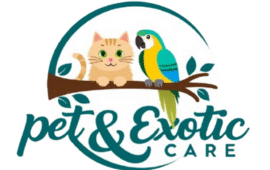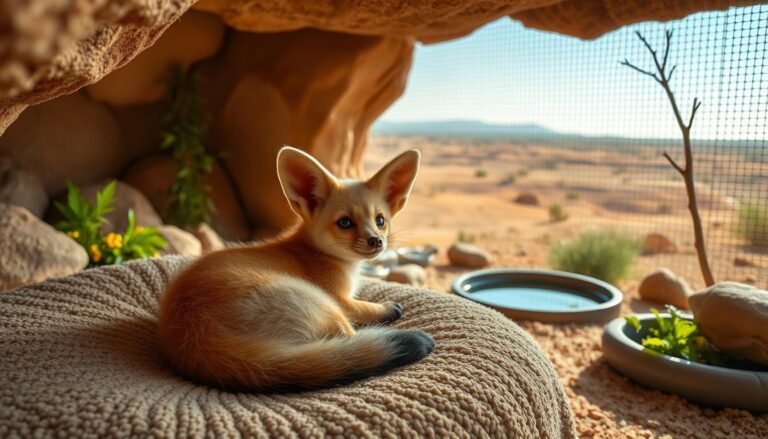“Fennec Fox Enclosure Size Requirements: Space and Enrichment Tips”
Discover the ideal fennec fox enclosure size requirements for a happy and healthy pet. Learn about space and enrichment tips in our ultimate guide.
Are you considering bringing a fennec fox into your home as a pet? If so, you’re likely wondering what kind of space and environment they require to thrive.
Fennec foxes, despite their small stature, are high-energy animals that need ample room to move and engage in natural behaviors. Providing an appropriate enclosure is crucial for their physical and mental well-being.
A well-designed enclosure not only ensures the health and happiness of your pet but also helps mitigate potential behavioral issues that can arise from inadequate housing.
Key Takeaways
- Minimum enclosure dimensions for fennec foxes
- Importance of enrichment activities for mental stimulation
- Considerations for indoor and outdoor housing options
- Natural behaviors to be accommodated in the enclosure
- Common issues resulting from inadequate enclosure size
Understanding Fennec Fox Housing Needs
Understanding the specific needs of fennec foxes is crucial for providing them with a comfortable and safe living space. Fennec foxes are exotic animals with specialized care needs that differ significantly from domestic pets like dogs and cats.
Fennec foxes require a lot of space to move around, dig, and climb. Their enclosures should be designed to accommodate these natural behaviors.
Minimum Space Requirements for Fennec Foxes
Fennec foxes need significantly more space than their small size might suggest. A minimum enclosure size of 8x8x5 feet is recommended for a single fennec fox. For multiple fennec foxes, the enclosure size should be proportionally larger, with a recommended size of at least 13x13x5 feet for 3-4 foxes.
| Number of Fennec Foxes | Minimum Enclosure Size (feet) |
|---|---|
| 1 | 8x8x5 |
| 3-4 | 13x13x5 |
Temperature and Environmental Considerations
Temperature control is essential for fennec fox enclosures. These desert animals need environments maintained above 68 degrees Fahrenheit at all times. Heat pads, heat lamps, or space heaters may be necessary additions to fennec fox enclosures in cooler climates. Additionally, environmental considerations include humidity levels, ventilation, and protection from extreme weather conditions.

Legal Requirements for Keeping Fennec Foxes
Before acquiring a fennec fox as a pet, it’s essential to research state, county, and city regulations, as many jurisdictions have specific legal requirements or prohibitions. Not every state allows keeping a fennec fox as a pet, and even if the state does, local restrictions may apply.
By understanding these housing needs, you can create a suitable environment for your fennec fox, ensuring their health and well-being.
Fennec Fox Enclosure Size Requirements
The size and setup of a fennec fox enclosure are critical factors in providing a suitable environment for these unique animals. Fennec foxes are active and require ample space to engage in natural behaviors such as playing, foraging, and hiding.
Indoor Enclosure Dimensions and Setup
When setting up an indoor enclosure for fennec foxes, it’s crucial to provide sufficient space for movement and activity. The minimum recommended size for a single fennec fox is 8x8x5 feet. The enclosure should have solid flooring and secure walls to prevent escape. It’s also important to include areas for different activities such as sleeping, eating, playing, and eliminating waste. This can be achieved by incorporating various zones within the enclosure.

Outdoor Enclosure Specifications
Outdoor enclosures for fennec foxes require more robust construction to ensure safety and security. The recommended minimum size for a single fennec fox is still 8x8x5 feet, but larger enclosures are preferable. The enclosure should be constructed with 12-gauge welded wire to protect against predators. Concrete or buried wire flooring is necessary to prevent digging escapes, and complete roofing is required to protect from aerial predators and prevent escape. Weatherproofing with sheltered areas is also essential to protect fennec foxes from rain, wind, and direct sunlight.
Multi-Fox Housing Considerations
When housing multiple fennec foxes together, the enclosure size must be increased proportionally. For a group of 3-4 fennec foxes, the enclosure should be at least 13x13x5 feet. Larger enclosures are always better, as they allow for a variety of enrichment activities and reduce the likelihood of conflict between the animals. It’s also important to ensure that the enclosure is well-ventilated and provides adequate hiding spots and visual barriers.
By considering these factors and providing appropriately sized and designed enclosures, fennec fox owners can help ensure the health, happiness, and well-being of their pets.
Building a Safe and Secure Fennec Fox Habitat
Fennec foxes require a specifically designed habitat that addresses their unique needs for safety and enrichment. Their enclosures must be escape-proof, given their exceptional digging and climbing abilities.
Enclosure Materials and Construction
The choice of materials for the enclosure is critical. 16-gauge welded wire with openings no larger than 1×1.5 inches is recommended to prevent escapes. The enclosure must have a full top and bottom; the top can be either a full roof or welded wire, while the bottom should be either buried welded wire, concrete, or wood to prevent digging escapes.
When constructing the enclosure, it’s essential to pay special attention to corners and seams where weaknesses might occur. Using durable materials and ensuring that there are no gaps or openings that could allow escape or cause injury is crucial.
Preventing Escape: Digging and Climbing Barriers
Fennec foxes are adept at both digging and climbing, necessitating robust barriers to prevent escape. For flooring, options include buried welded wire extending at least 12 inches underground, concrete, or sealed wood. Roofing should be either solid or secure welded wire to prevent climbing escapes.
- Buried welded wire or concrete can effectively prevent digging escapes.
- Secure welded wire or solid roofing prevents climbing escapes.
- Regular inspection of the enclosure’s integrity is necessary to identify and repair any weaknesses.
Safety Features and Access Points
Safety features are vital to prevent escapes and injuries. A double-door entry system (catch door) is essential for safe interaction with your fennec fox. Additionally, enclosures should have rounded edges, no exposed wires, and secure latches that cannot be manipulated by the foxes.
Access points should be designed for easy maintenance while maintaining security. Lockable doors are recommended for outdoor enclosures to ensure that your fennec fox remains safe and secure.
Essential Enrichment for Fennec Fox Enclosures
Providing a stimulating environment is crucial for the well-being of fennec foxes in captivity. A well-designed enclosure that incorporates naturalistic elements and enrichment activities can significantly enhance the quality of life for these unique animals.
Natural Substrate Options for Digging
Fennec foxes are known for their digging behavior, and providing a suitable substrate is essential for encouraging this natural activity. Sand is the ideal substrate as it mimics their desert habitat and allows for digging and burrowing. Including animal-safe scrub vegetation and succulents can also enhance the enclosure’s naturalistic feel.
Dens, Shelters, and Resting Areas
Fennec foxes need secure and private areas to rest and hide. Providing multiple den options such as enclosed boxes, hollow logs, and artificial burrows can cater to their need for security. Hollow logs and other sheltered areas can serve as hiding spots and resting places, while flat rocks in sunny areas offer basking spots for thermoregulation.
Climbing Structures and Elevated Platforms
Climbing structures and elevated platforms are vital for providing fennec foxes with opportunities for exercise and observation. Secure branches, ramps, and platforms can be used to create a multi-level enclosure that stimulates their natural climbing behavior.
Toys and Mental Stimulation Items
Toys and enrichment items play a crucial role in stimulating the mental and physical health of fennec foxes. Durable toys that encourage chewing, carrying, and interactive play can help prevent boredom and stress. Puzzle feeders and rotating toys can provide mental stimulation, while hiding insects or small amounts of food can encourage foraging behaviors.
| Enrichment Item | Description | Benefits |
|---|---|---|
| Sand Substrate | Mimics natural desert habitat | Encourages digging and burrowing |
| Hollow Logs | Provides sheltered areas | Offers hiding spots and resting places |
| Climbing Structures | Secure branches and platforms | Promotes exercise and observation |
| Puzzle Feeders | Challenges and stimulates | Prevents boredom and stress |
Maintaining Your Fennec Fox Habitat
Proper habitat maintenance is vital for fennec foxes, requiring regular checks and updates. This includes ensuring the enclosure remains clean and safe, with daily spot cleaning and weekly deep cleaning recommended to prevent the buildup of waste and bacteria.
Regular veterinary care is also crucial, necessitating a specialized exotic animal veterinarian experienced with fennec foxes or similar species. Establishing a feeding routine is essential, with a diet consisting of high-quality commercial foods, whole prey items, and appropriate supplements.
Fennec foxes require a temperature-controlled environment, with systems in place to maintain warmth during colder months. Socialization and handling time should be incorporated into daily care routines to maintain tameness and monitor health. Training considerations, such as litter box and leash training, are also important for supervised time outside the enclosure.
To integrate your fennec fox into your home, careful planning is necessary, including supervised time outside the enclosure and fox-proofing any areas the fennec will access. Seasonal adjustments may be necessary for outdoor enclosures, with additional heating in winter and cooling/shade in summer. Long-term maintenance involves regular inspection of enclosure integrity and updates to meet changing needs as your fennec fox ages.



